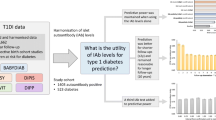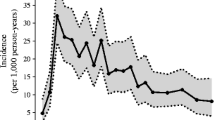Abstract
Aims
Stable genetic background makes individuals from the Mediterranean island of Sardinia ideal to define the predictive power of islet-related autoantibodies (IRAs): glutamic acid decarboxylase antibodies (GADA), tyrosine phosphatase-like antibodies (IA-2A), islet cell antibodies (ICA) to identify T1DM progressors. The aims of the present study were: (1) determination of IRAs reference limits in healthy non-diabetic Sardinian schoolchildren (SSc). (2) Predictive power evaluation of IRAs as single or combined determination to identify islet to identify T1DM progressors.
Methods
Between 1986 and 1994, 8448 SSc were tested for IRAs. All were followed up for 10 years. The predictive power of single or combination of IRAs was determined as hazard ratio (HR), sensitivity, specificity, area under the ROC curve, negative and positive predictive value (NPV, PPV).
Results
All 43 progressors to T1DM, but three showed at least one autoantibody positivity. HR for any single-autoantibody positivity was 55.3 times greater when compared to SSc negative for all IRAs. Any single autoantibody performed at least 64.9 % sensitivity with PPV always lower than 16 %. The best performing combination was ICA, plus IA-2A (showing 52.6 % sensitivity, 99.8 % specificity, 0.76 area under the ROC curve, 51.3 % PPV and 99.8 % NPV.
Conclusions
Determination of IRAs reference limits in healthy SSc by standard statistical methods is crucial to establish the power of IRAs as progression markers to T1DM. Our data offer a solid rationale for future testing of ICA and IA-2A as routine laboratory markers to identify individuals at high risk of T1DM in the general population.

Similar content being viewed by others
Abbreviations
- SSc:
-
Sardinian schoolchildren
- FH:
-
Family history
- TD:
-
Thyroid disease
- T1DM:
-
Type 1 diabetes mellitus
- IRAs:
-
Islet-related autoantibodies
- ICA:
-
Islet cell antibodies
- GADA:
-
Glutamic acid decarboxylase antibodies
- IA-2A:
-
Protein tyrosinephosphatase-like IA-2
- IAA:
-
Insulin autoantibodies
References
Hattersley AT (1997) Genes versus environment in insulin-dependent diabetes: the phoney war. Lancet 349:147–148
Ko KW, Yang SW, Cho NH (1994) The incidence of IDDM in Seoul from 1985 to 1988. Diabetes Care 17:1473–1475
Soltesz G, Patterson CC, Dahlquist G (2007) Worldwide childhood type 1 diabetes incidence–what can we learn from epidemiology? Pediatr Diabetes 8(Suppl 6):6–14
Green A, Gale EA, Patterson CC (1992) Incidence of childhood-onset insulin-dependent diabetes mellitus: the EURODIAB ACE study. Lancet 339:905–909
Songini M, Loche M, Muntoni S et al (1993) Increasing prevalence of juvenile onset type 1 (insulin-dependent) diabetes mellitus in Sardinia: the military service approach. Diabetologia 36:547–552
Casu A, Pascutto C, Bernardinelli L, Songini M (2004) Type 1 diabetes among sardinian children is increasing: the Sardinian diabetes register for children aged 0–14 years (1989–1999). Diabetes Care 27:1623–1629
Casu A, Trucco M, Pietropaolo M (2005) A look to the future: prediction, prevention, and cure including islet transplantation and stem cell therapy. Pediatr Clin North Am 52:1779–1804
Cavalli-Sforza LL, Piazza P (1993) Human genomic diversity in Europe: a summary of recent research and prospects for the future. Eur J Hum Genet 1:3–18
Cappello N, Rendine S, Griffo R et al (1996) Genetic analysis of Sardinia: I. data on 12 polymorphisms in 21 linguistic domains. Ann Hum Genet 60:125–141
Bottazzo GF, Loviselli A, Velluzzi F et al (1997) The “Sardinia-IDDM study”: an attempt to unravel the cause of insulin-dependent diabetes mellitus in one of the countries with the highest incidence of the disease in the world. Ann Ist Super Sanita 33:417–424
Bottazzo GF, Florin-Christensen A, Doniach D (1974) Islet-cell antibodies in diabetes mellitus with autoimmune polyendocrine deficiencies. Lancet 2:1279–1283
Palmer JP, Asplin CM, Clemons P et al (1983) Insulin antibodies in insulin-dependent diabetics before insulin treatment. Science 222:1337–1339
Baekkeskov S, Aanstoot HJ, Christgau S et al (1990) Identification of the 64K autoantigen in insulin-dependent diabetes as the GABA-synthesizing enzyme glutamic acid decarboxylase. Nature 347:151–156
Payton MA, Hawkes CJ, Christie MR (1995) Relationship of the 37,000- and 40,000-M(r) tryptic fragments of islet antigens in insulin-dependent diabetes to the protein tyrosine phosphatase-like molecule IA-2 (ICA512). J Clin Invest 96:1506–1511
Bonifacio E, Lampasona V, Genovese S, Ferrari M, Bosi E (1995) Identification of protein tyrosine phosphatase-like IA2 (islet cell antigen 512) as the insulin-dependent diabetes-related 37/40K autoantigen and a target of islet-cell antibodies. J Immunol 155:5419–5426
Seissler J, Hatziagelaki E, Scherbaum WA (2001) Modern concepts for the prediction of type 1 diabetes. Exp Clin Endocrinol Diabetes 109(Suppl 2):S304–S316
Taplin CE, Barker JM (2008) Autoantibodies in type 1 diabetes. Autoimmunity 41:11–18
LaGasse JM, Brantley MS, Leech NJ et al (2002) Successful prospective prediction of type 1 diabetes in schoolchildren through multiple defined autoantibodies: an 8-year follow-up of the Washington State Diabetes Prediction Study. Diabetes Care 25:505–511
Strebelow M, Schlosser M, Ziegler B, Rjasanowski I, Ziegler M (1999) Karlsburg type I diabetes risk study of a general population: frequencies and interactions of the four major type I diabetes-associated autoantibodies studied in 9419 schoolchildren. Diabetologia 42:661–670
Norris JM, Yin X, Lamb MM et al (2007) Omega-3 polyunsaturated fatty acid intake and islet autoimmunity in children at increased risk for type 1 diabetes. JAMA 298:1420–1428
Loviselli A, Velluzzi F, Mossa P et al (2001) The Sardinian Autoimmunity Study: 3. Studies on circulating antithyroid antibodies in Sardinian schoolchildren: relationship to goiter prevalence and thyroid function. Thyroid 11:849–857
Songini M, Bernardinelli L, Clayton D et al (1998) The Sardinian IDDM study: 1. Epidemiology and geographical distribution of IDDM in Sardinia during 1989 to 1994. Diabetologia 41:221–227
Palmer JP, Wilkin TJ, Kurtz AB, Bonifacio E (1990) The third international workshop on the standardisation of insulin autoantibody measurement. Diabetologia 33:60–61
Bonifacio E, Lernmark A, Dawkins RL (1988) Serum exchange and use of dilutions have improved precision of measurement of islet cell antibodies. J Immunol Methods 106:83–88
Petersen JS, Hejnaes KR, Moody A et al (1994) Detection of GAD65 antibodies in diabetes and other autoimmune diseases using a simple radioligand assay. Diabetes 43:459–467
Seissler J, Morgenthaler NG, Achenbach P et al (1996) Combined screening for to IA-2 and antibodies to glutamic acid decarboxylase in first degree relatives of patients with IDDM. The DENIS Study Group. Deutsche Nikotinamid Interventions-Studie. Diabetologia 39:1351–1356
Verge CF, Stenger D, Bonifacio E et al (1998) Combined use of (IA-2 autoantibody, GAD autoantibody, insulin autoantibody, cytoplasmic islet cell antibodies) in type 1 diabetes: combinatorial islet autoantibody workshop. Diabetes 47:1857–1866
Reed AH, Henry RJ, Mason WB (1971) Influence of statistical method used on the resulting estimate of normal range. Clin Chem 17:275–284
American Diabetes Association (2010) Diagnosis and classification of diabetes mellitus. Diabetes Care 33(Suppl 1): S62–S69
Frongia O, Mastinu F, Sechi GM (1997) Prevalence and 4-year incidence of insulin-dependent diabetes mellitus in the province of Oristano (Sardinia, Italy). Acta Diabetol 34:199–205
Bruining GJ, Molenaar JL, Grobbee DE et al (1989) Ten-year follow-up study of islet-cell antibodies and childhood diabetes mellitus. Lancet 1:1100–1103
Schatz D, Krischer J, Horne G et al (1994) Islet cell antibodies predict insulin-dependent diabetes in United States school age children as powerfully as in unaffected relatives. J Clin Invest 93:2403–2407
Levy-Marchal C, Dubois F, Noel M, Tichet J, Czernichow P (1995) Immunogenetic determinants and prediction of IDDM in French schoolchildren. Diabetes 44:1029–1032
Genovese S, Bingley PJ, Bonifacio E et al (1994) Combined analysis of IDDM-related autoantibodies in healthy schoolchildren. Lancet 10. 344(8924):756
Bonifacio E, Genovese S, Braghi S et al (1995) Islet autoantibody markers in IDDM: risk assessment strategies yielding high sensitivity. Diabetologia 38(7):816–822
Bingley PJ, Bonifacio E, Williams AJ et al (1997) Prediction of IDDM in the general population: strategies based on combinations of autoantibody markers. Diabetes 46(11):1701–1710
Samuelsson U, Sundkvist G, Borg H, Fernlund P, Ludvigsson J (2001) Islet autoantibodies in the prediction of diabetes in school children. Diabetes Res Clin Pract 51:51–57
Kulmala P, Rahko J, Savola K et al (2001) Beta-cell autoimmunity, genetic susceptibility, and progression to type 1 diabetes in unaffected schoolchildren. Diabetes Care 24:171–173
Knip M, Korhonen S, Kulmala P et al (2010) Prediction of type 1 diabetes in the general population. Diabetes Care 33(6):1206–1212
Lebastchi J, Deng S, Lebastchi AH et al (2013) Immune therapy and beta-cell death in type 1 diabetes. Diabetes 62:1676–1680
Jimenez-Gonzalez M, Jaques F, Rodriguez S et al (2013) Cardiotrophin 1 protects beta cells from apoptosis and prevents streptozotocin-induced diabetes in a mouse model. Diabetologia 56:838–846
Acknowledgment
S.M. was supported by Ministero della Salute (Rome, Italy, Grant No. ICS 120.2/RF99.17).
Conflict of interest
The authors declare that there is no conflict of interest associated with this manuscript.
Ethical standard
The study protocol conformed to the principles of the Declaration of Helsinki and was approved by Department of Medical Sciences “Mario Aresu” University of Cagliari, Ethics Committee.
Human and Animal Rights
This article does not contain any studies with human or animal subjects performed by any of the authors.
Informed consent
Informed consent was obtained from all patients for being included in the study.
Author information
Authors and Affiliations
Consortia
Corresponding author
Additional information
Managed by Massimo Porta.
The Sardinian Autoimmunity Study Group is given in the “Appendix”.
Appendix
Appendix
The author group is part of the Sardinia Autoimmunity Study Groups’, which include:
General Management
Overall Scientific and Administrative Responsibility: M. Songini (Cagliari), GF. Bottazzo (Rome)
General Co - ordinator: M. Locatelli (Rome);
The Immnunological and Genetic Study Group: Responsible: G.F. Bottazzo (Cagliari-Rome), E. Bonifacio (Milano).
Local Overall Responsibility: M. Songini (Cagliari)
The Epidemiology Study Group, The Statistical Group: Responsible: M. Songini (Cagliari);
The School Children Study Group: Responsibles: A. Loviselli, F. Velluzzi (Cagliari);
Co - ordinator: S. Mariotti (Cagliari);
Physicians and Laboratory Personnel: A. Pilo, G. Pinna, G. Secci, A. Taberlet.
Field workers: P. Mele, M.A. Calia, R. Mastinu, A. Pilleri, S. Serra, M. Diliberto, E. Rizzolo, N. Costantini.
Family GPs in the Provinces: L. Curreli, Serramanna (Ca), A. Trincas, Cabras (Or), M. Lara, S. Melis, L. Melis, G. Uggias, M. Incollu, Baunei (Og), S. Serra, Urzulei (Og), A. Seoni, S. Monni, Villagrande (Og), M. Muntoni, Ulassai (Og), M. Moi, Perdasdefogu (Og), F. Calzone, I. Ena, A. Manca, Bitti (Og), A. Lai, E. Floris, Tertenia (Og), M. Orrù, G. Melis, G. Mou, A. Deplano, Jerzu (Og).
CAD Sardinia:CAD Cagliari, CAD Sassari, CAD Oristano, CAD Nuoro, CAD Lanusei-Tortolì, CAD Olbia, CAD Tempio, CAD Carbonia, CAD Iglesias, CAD Quartu S.E., CAD Senorbì, CAD San Gavino M., CAD Bosa, CAD Isili, CAD Alghero, CAD Tempio Pausania, CAD Ozieri, CAD Santa Teresa di Gallura, CAD LA Maddalena, CAD Arzachena, CAD Bono, CAD Muravera, CAD Siniscola-Orosei, CAD Oristano.
Rights and permissions
About this article
Cite this article
Velluzzi, F., Secci, G., Sepe, V. et al. Prediction of type 1 diabetes in Sardinian schoolchildren using islet cell autoantibodies: 10-year follow-up of the Sardinian schoolchildren type 1 diabetes prediction study. Acta Diabetol 53, 73–79 (2016). https://doi.org/10.1007/s00592-015-0751-y
Received:
Accepted:
Published:
Issue Date:
DOI: https://doi.org/10.1007/s00592-015-0751-y




